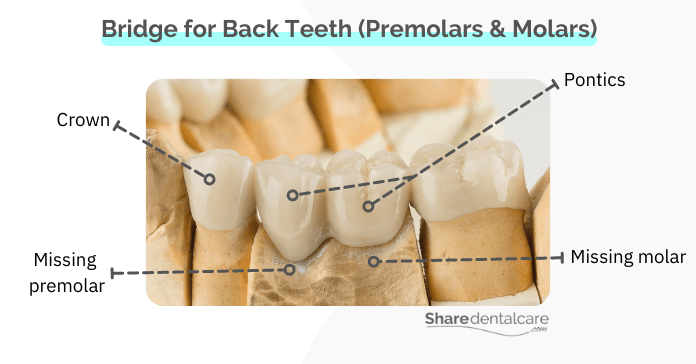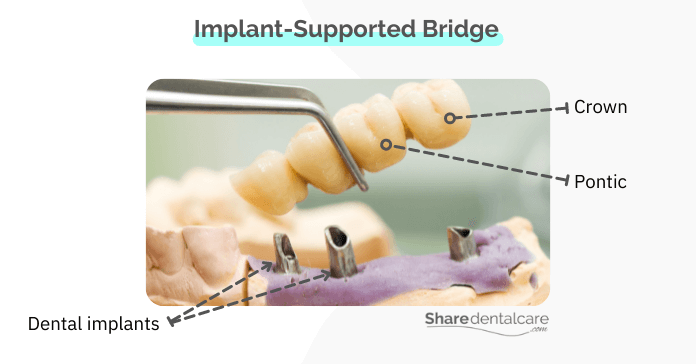A dental bridge is a perfect solution for back teeth (molars & premolars) that have been lost due to injury, decay, or gum disease. Bridges are a popular form of dental restoration. They can replace missing back teeth such as premolars and molars, and restore the chewing function. This is done by connecting two or more crowns to the healthy teeth on either side of the gap. Dental bridges have many benefits for oral health and can be used for a variety of reasons!
The popularity of dental bridges has been growing over the years because they offer so much in terms of restoring both appearance and functionality to someone’s mouth, all while still looking natural. In this article, we will discuss the benefits of dental bridges for back teeth as well as provide information on some common bridge types.
Why Should I Replace Missing Back Teeth (molars & premolars)?
The loss of back teeth is a common problem. Back teeth include premolars and molars, which are very important to your bite and chewing function. Some of the most common problems associated with losing back teeth, especially molars, are:
- Difficulty chewing foods: the loss of premolars and molars can make it hard to chew certain foods that you used to be able to eat without much trouble. For example, eating an apple or a steak.
- Jaw bone loss: the lack of molars can also lead to jaw bone loss. This is because the molars are used for chewing, and chewing stimulates your jaw bone which creates new cells to support it. As a result, losing back teeth can result in a loss of jaw bone over time.
- Wear & tear of adjacent teeth: this is because the loss of premolars and molars leads to an increase in the stress from chewing placed on your remaining teeth, which can result in premature wear of surrounding teeth.
- TMJ disorders: when you lose back teeth, it creates an issue in the way you chew and eat food, which can directly affect your jaw joint.
- Poor nutrition: having teeth missing can also affect your ability to properly chew and swallow your food. This in turn affects the way your body absorbs nutrients from the foods you eat, which can lead to nutritional deficiencies and affect your overall health.
So, you should consider getting a fake tooth for missing back teeth to avoid these problems.
What is a Dental Bridge for Back Teeth?
A dental bridge for back teeth is a fixed prosthesis that is used to replace one or more missing premolars and/or molars in the upper and lower jaw. A fake tooth bridge can be made from many materials such as alloys, ceramics, porcelain fused to metal, and/or a combination of materials.
The main idea behind a dental bridge is that it bridges the gap created by missing back teeth. A standard bridge is composed of two crowns (abutments), which are placed on either side of the missing teeth so that they can support a false tooth/teeth (pontic) in between them.

Benefits of a Dental Bridge for Back Teeth
A dental bridge for back teeth can provide many benefits to someone who has lost one or more premolars and/or molars. The main benefits include:
- Restoring chewing function, which in turn helps you to eat a balanced diet again by allowing you to enjoy foods that are harder or softer than what your remaining teeth can handle on their own. Bridges for back teeth (molars & premolars) have a positive effect on your overall health.
- Support adjacent teeth: filling in the gaps created by missing premolars and molars protects the adjacent natural teeth by preventing them from getting damaged by chewing forces.
- Aesthetic reasons: since dental bridges for back teeth are used to fill gaps, having one can make your smile appear complete again.
- Prevent jaw bone loss: getting an implant-supported bridge for back teeth can slow down or even stop jaw bone tissue loss. We will discuss implant-supported bridges in the next section.
Types of Dental Bridges for Back Teeth
Choosing the type of dental bridge suitable for you depends on several factors, including what is missing, how many teeth are missing, and whether you would like to use implants to support a dental bridge. There are several bridge types in dentistry for missing back teeth include:
Traditional Bridges
The traditional bridge is supported by two or three adjacent natural teeth (abutments). Read more about the benefits & drawbacks of a bridge for two missing teeth.
- Advantages of traditional bridges: they are more affordable and less invasive than dental implants.
- Disadvantages of traditional bridges: they can be used only when there are teeth on both sides of the gap. Also, traditional bridges can’t compensate for jaw bone loss.
Implant-Supported Bridges
An implant-supported bridge is supported by two or more implants.
- Advantages of implant-supported bridges: they can be used when there are no teeth on either side of the gap. Implants are suitable for adults with no teeth. Dental implants are strong, durable, and provide long-lasting support for a back teeth bridge.
- Disadvantages of implant-supported bridges: they are more expensive than traditional bridges, and require a surgical procedure for the placement of implants.

Bridge for Back Teeth (molars & premolars) – Conclusion
Dental bridges are a great way to replace missing back teeth (molars & premolars) and restore functionality, which can help you lead a healthier lifestyle. The available types include traditional and implant-supported bridges, and each type has its benefits to consider. If your dentist recommends that you get one, they will work with you to find the best option for your oral health needs and budget. Read more about missing back teeth replacement options.